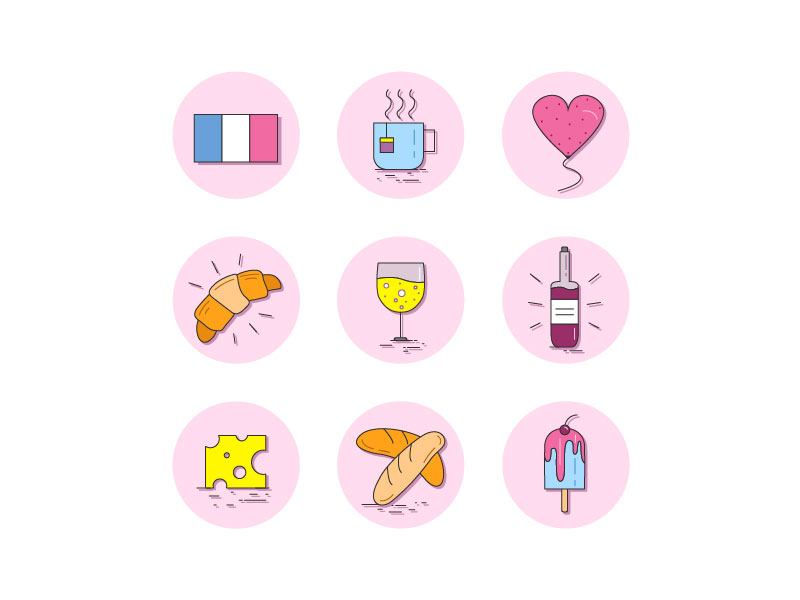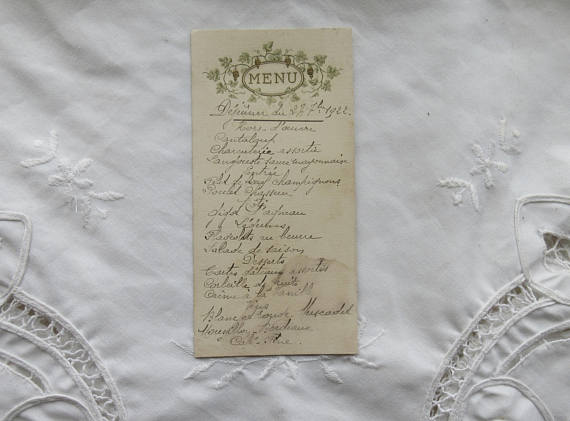15+ French Menu Examples to Download
You have to admit that when it comes to food, it seems that French has almost a term for everything. Dining at some fancy French restaurant can be overwhelming not because of the environment but because of their attractive menu— what if the only French word you know of is Bonjour? What if you would pick something from their menu just because it’s fancy to read? Expect that you can possibly order a plate of bleeding beef.
French Sandwich Sub Menu Template

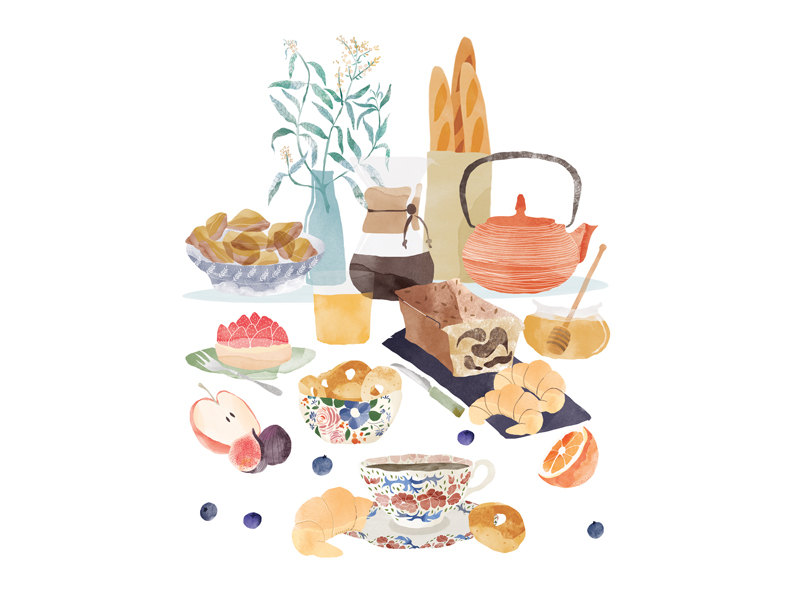
However, do not fret because this article got you covered and can definitely help you when you find yourself dumbfounded browsing a French menu. We have also provided fifteen examples of French menu you can get familiar with and if ever you own a French cuisine restaurant, you can definitely get inspiration from the templates we have here for you. You may also see sumptuous seafood menu examples.
Vintage French Country Menu Card Example
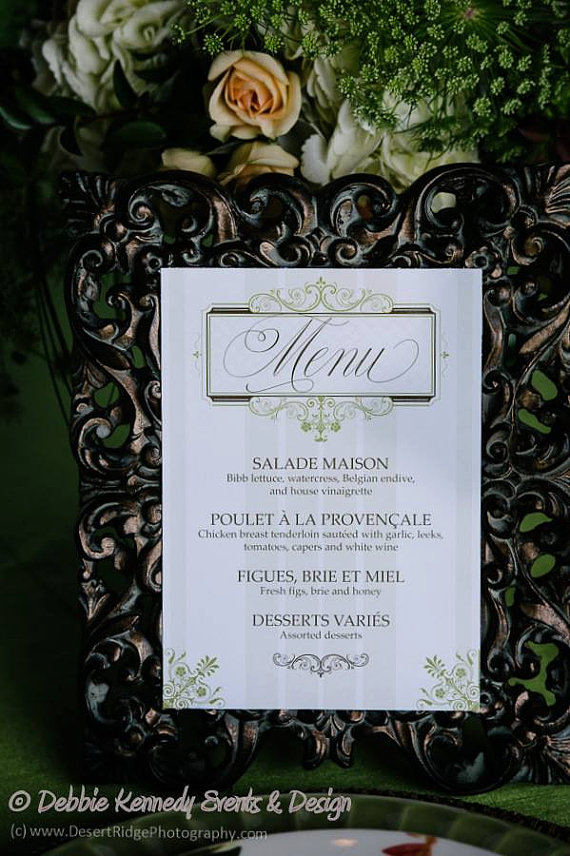
French Chandelier Wedding Menu Card
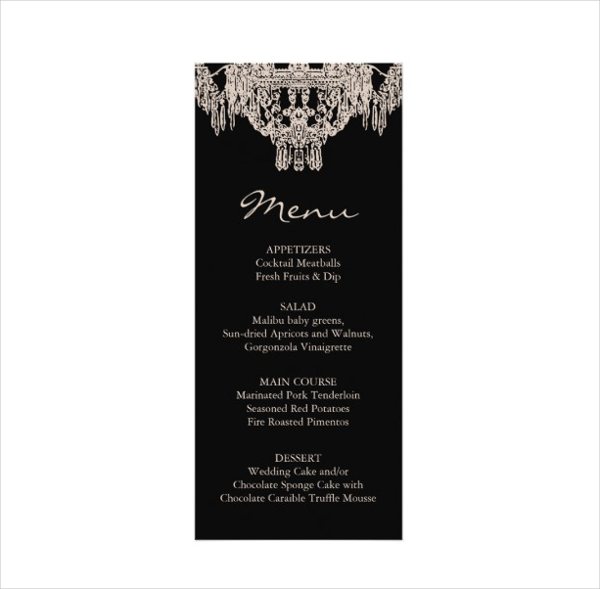
Vintage French Menu Card Example
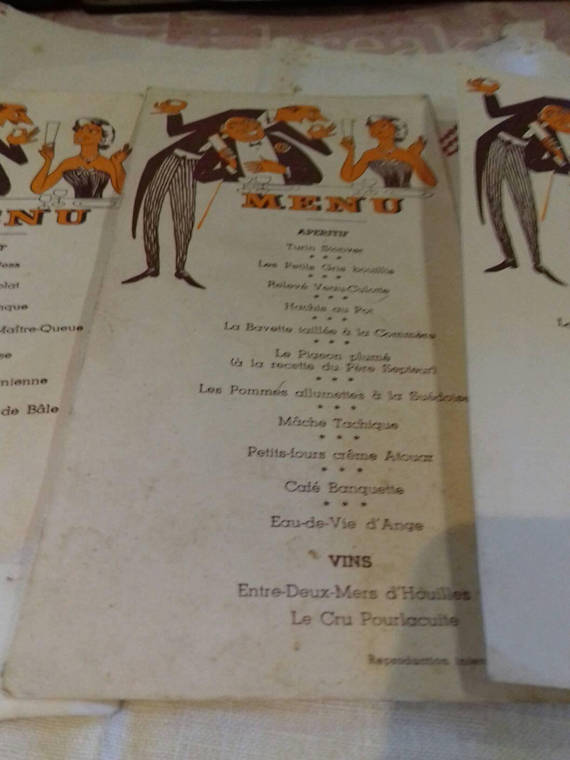
Simple Stripe French Blue Wedding Menu Card
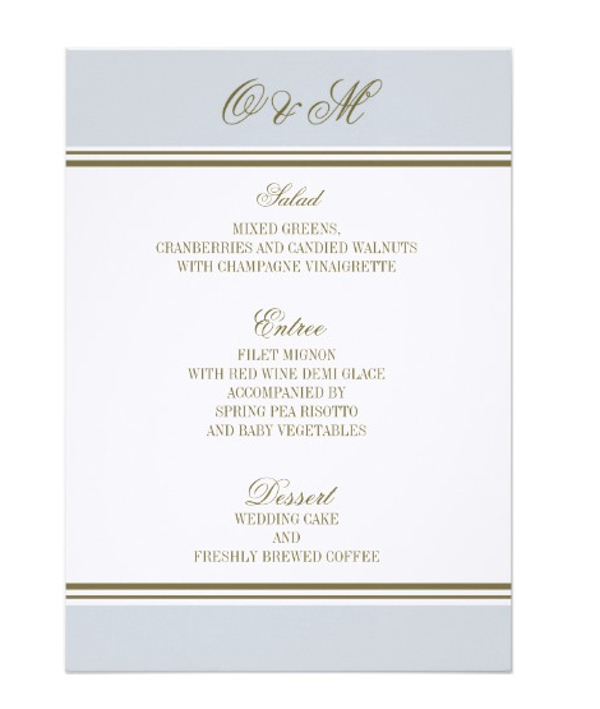
Vintage French Byrrh Wine Menu Example
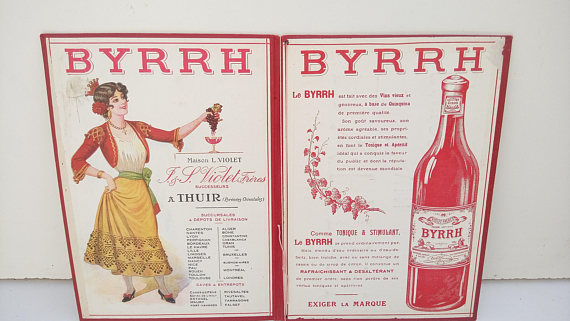
Vintage French Butcher Example

Miniature French Restaurant Menu Example
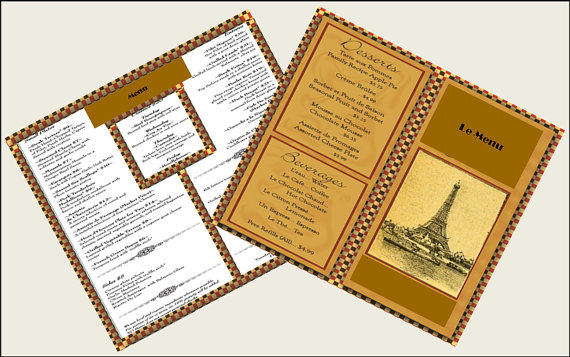
The Different French Terms Related to Food and Other Cooking Methods
Remove that confusion in your head whenever you would dine in French restaurants with the help of these French menu terms. You may also see cafe menu designs.
1. Basic Terms
- La carte – English speakers know this as the “menu” or even the booklet or a sheet of paper handed by the waiter which contains the list of food that the restaurant has to offer.
- Le menu – English speakers know this as the fixed price menu or a set menu which is also the set price for two or more courses. If you want a less expensive way to order your food, then make sure you ask for this from your waiter. Another term for this is “la formule”. You may also like pasta menu designs and examples.
- L’ardoise – See those boards where the specials or the set menu selections for the day are written? This is the French term for it and it literally means “slate”. These are usually found and displayed in front or at the entrance of a restaurant.
- La carte des vins – This is the wine menu.
- Une dégustation / Menu dégustation – This is the tasting elegant menu which contains a variety of small portions from the several dishes the restaurant serves. The term dégustation comes from the French verb ‘deguster’ which means in English as ‘to taste’.
- à la carte – This is by far the most common French term we can hear and see on at the restaurant, even those non-French restaurants. This is the stand-alone or the single items that you can find and order from the modern menu and it has its own price.
- plats du jour – This literally means as the “dish of the day” which is a daily special by most of the French restaurants in France.
Here are some French terms that can help you get started in understanding any kind of French menu and this can also help you when you find yourself in a French restaurant:
- affiné- aged
- artisanal– homemade, traditionally made
- à la broche- cooked on a skewer
- à la vapeur– steamed
- à l’etouffée- stewed
- aufour- baked
- biologique, bio- organic
- bouilli- boiled
- brûlé– burnt
- coupé en dés– diced
- coupé en tranches / rondelles– sliced
- Cru– raw
- cuit- cooked
- en croûte- in a crust
- en daube- in stew, casserole
- en gelée- in aspic/gelatin
- farci- stuffed
- fondu- melted
- frit- fried
- fumé– smoked
- glacé– frozen, icy, glazed
- grillé- grilled
- haché- minced, ground (meat)
- maison– homemade
- poêlé- panfried
- Poché– poached
- relevé- highly seasoned, spicy
- séché- dried
- truffé- with truffles
- truffé de ___– dotted/speckled with ___
- Rôti- roast
You may also check out examples of lunch menu designs.
2. The Different Courses / Food Categories You’ll Find in a French La Carte
- un apéritif – a pre-dinner drink or a cocktail
- un amuse-bouche or amuse-gueule – small snacks
- une entrée – English speakers refers to this as the “appetizers” or “starters”
- le plat principal – English speakers refer this as the main dish or the entrée
- Accompagnement – side dish; “accompaniment”
- le fromage – cheese
- le dessert – dessert
- le café – coffee
- un digestif – a drink you drink after-dinner
You might be interested in chinese food menu designs & examples.
Have you tried ordering meat, asked how you it to be cooked and you just choose whatever there is on the La Carte and end up ordering a bleeding meat? You might want to take note of the following:
- Saignant – This means that the meat is cooked rare. This is the bleeding meat you might have ordered once in a French restaurant. Saignant literally means “bleeding”. This is pronounced as “sahn-yahnt”.
- A point – This means that the meat is cooked medium rare. This is pronounced as “ah pwanh”.
- Bien cuit – This means that the meat is cooked “well done” This is pronounced as “byen kwee”.
- Brûlé – This means that the meat is burnt. This is pronounced as “broo-lee”.
You may also like typography menu examples.
French Food Menu Example

French Antique Printed Menu Example
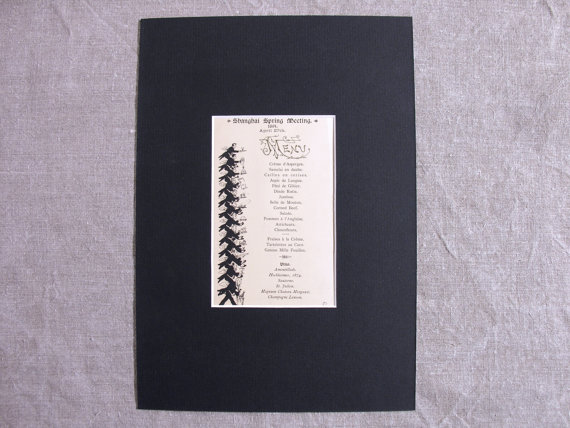
French Printable Wedding Menu Card Example
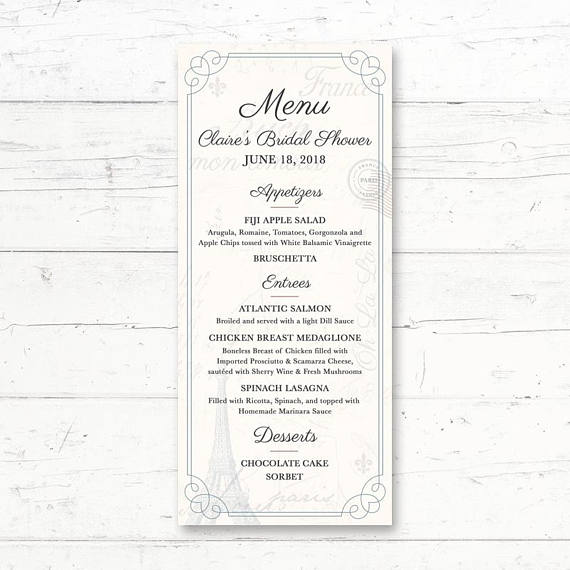
Vintage French Brasserie Menu Example
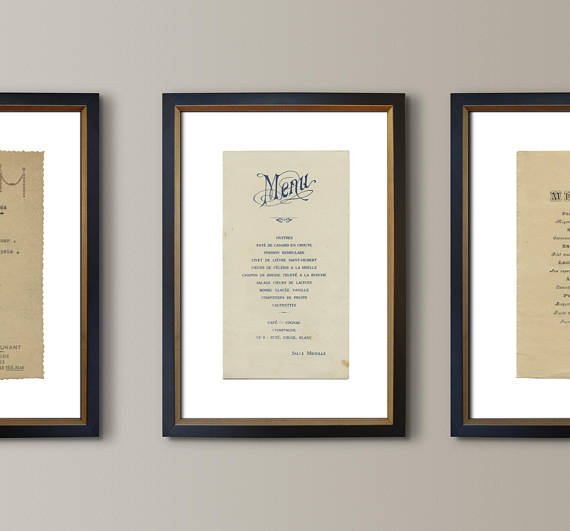
Classic French Menu Chalkboard Example
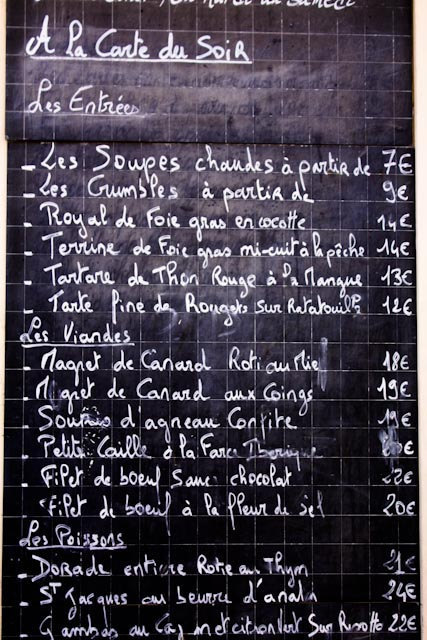
Antique Vintage French Menu Example
1905 Antique Vintage French Menu Example
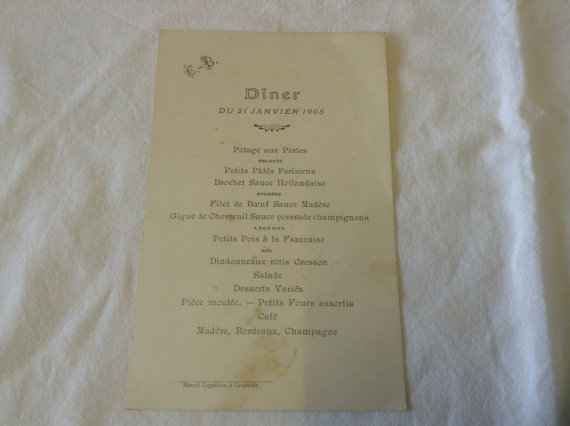
Top French Dishes You Should Never Miss Out
French foods are famous for having this irresistible finesse and flavor. We all know that France is known for their best wines and cheeses. This is why wine and food pairing is given much regard in France even at dinner parties that are informal. But beyond the famous French wine and cheese, you might have also heard of the mixture of traditional peasant and bourgeois French dishes. Each kind of dish has come a long way from the past, each with unique long histories, regional variations, and even modern adaptions. With that, here is a list of top French foods you should never miss out on a French menu:
1. Soupe à l’oignon
This translates to as “Onion Soup”. This a famous traditional French soup that contains onions and beef stock and are usually served along with croutons and melted cheese on top.
The origin of this soup goes as far back as the Romans and is typically a poor dish. One of the things you would expect from Soupe à l’oignon is the taste of the caramelized onions. You can also taste brandy or sherry because there are some variations of this dish wherein brandy or sherry is added, particularly at the end of the slow-cook process. The soup or the liquid is usually meat stock but there are some variations wherein they would just use water or some would also add milk. You may also see barbecue menu examples.
2. Boeuf Bourguignon
Boeuf Bourguignon or Beef Bourguignon is a world-famous traditional French dish that is a stew made of beef that is braised in red wine. Along with the red wine includes beef broth and it is also seasoned with garlic, pearl onions, fresh herbs, and mushrooms.
The method of cooking the beef is to slowly simmer it well until the tough or even cheap cuts of beef will be tenderized. The traditional preparation time takes up to two days in order to tenderize the beef and it would also intensify the stew flavor. You may also like pizza menu samples and examples.
Like any other traditional peasant dishes, Boeuf Bourguignon is one of the peasant dishes that has been adopted into an haute cuisine.
3. Chocolate Souffle
Souffle is a French word that means ‘breath’ or ‘puff’ and the Chocolate Souffle dish is indeed a dish that looks like a breath or a puff because of its features that looks like an airy, baked egg dish. This dish usually comes with a crispy texture and once you would take a bite, you can hear a crunch and what follows after is an ooze of creamy chocolate that will surely give you a pleasant, delectable surprise. You may also check out salad menu samples.
The origin of this dish goes back in early 18th-century France. While there are other Souffles in other different flavors, such as lemon, you might have finally encountered Chocolate-flavored Souffles on various dessert la carte worldwide.
4. Crêpes
Crêpes is a type of very thin pastry that usually comes in two types which is the crêpes sucrées or the sweet crêpe and the crêpes salées or the savory galettes. Served along with crêpes are a variety of fillings that goes from simple (sugar) to those with elaborate savory galettes. You might be interested in coffee menu examples.
Crêpes are traditionally served in France during the celebration of the Candlemas, or the Feast of the Presentation of Our Lord Jesus, in every 2nd of February. Before, this day was known as the Virgin Mary’s Blessing Day but eventually became “Le Jour des Crêpes” which is literally translated as “The Day of the Crêpes”.
5. Bouillabaisse
This dish is a classic and traditional Provencal fish stew that originates from the port city of Marseilles, France. Bouillabaisse comes from the compound word ‘bolhabaissa‘, that also comes from the root words bolhir, which means to boil and abaissar, which means to reduce heat. What makes the preparation of this dish unique is that the ingredients are not added in one go; you start with boiling the broth first, the followed by adding the different kinds of fish one by one. You may also see examples of a food menu.
Usually, there are three kinds of fish that is used in cooking a traditional bouillabaisse: scorpionfish, sea robin, and a European conger.
6. Ratatouille
No, this is not the famous Pixar film but the dish that the movie is inspired from which is a globally known French stewed vegetable dish. Ratatouille can be served as a side dish or a meal. It can also be used as a stuffing for other dishes such as crepes.
To cook a Ratatouille, you have to make sure that the vegetables are cooked first in a shallow pan with high heat along with a small amount of fat. Right after doing so, you would have then to oven-bake it in a dish. While French chefs continue to debate about the correct way to cook ratatouille, the common ingredients used in cooking a Ratatouille are tomatoes, garlic, onions, zucchini, eggplant, carrots, bell peppers, basil, marjoram, thyme and other green herbs, such as Provence herbs. You may also like dinner menu samples.
We hope you were able to make use of these French menu examples that we have provided for you here in this article as well as gain insights about the French terms used in French menus. Bon Appetit!


